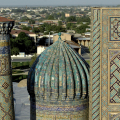REGISTAN'S PLACE
Go there and contact
In the past, the Registan was the heart of Samarkand, and a compact, colorful crowd bustled around the many stalls set up in the madrassas. The indefatigable Swiss traveler Ella Maillard was lucky enough to stay in one of Tilla Kari's cells when she visited in 1932. As for the Chir Dor madrasa, it was used as a place of detention for basmatchi - Muslims who opposed Soviet rule - awaiting execution. Here, as around the Gour Emir, the houses were demolished to make way. The three immense and superb madrasas, Ulough Begh, Chir Dor and Tilla Kari, line a large esplanade. On the fourth side of the esplanade, bleachers welcome visitors for sound and light shows.
In the 14th century, the six main arteries leading from the city gates intersected here, on a vast sandy square to soak up the blood spilt during public executions. Tamerlane wanted to facilitate trade and encourage merchants, who were paying heavy taxes, to come to Samarkand. He had a street lined with stores built, crossing the city from one end to the other, and a huge bazaar. Continuing his work, his wife, Tuman Aka, built the tim, a large domed covered market. Under the reign of Ulough Begh, in the early 15th century, the Registan became the official square of Samarkand. The domed market was demolished, and a madrasa, khanaka, caravanserai and mosque were built. A strategic site, at the end of the 15th century, when enemies were encircling Samarkand, Babur, the last of the Timurids, had set up his headquarters on top of the Ulough Begh madrasa.
To the west, the Ulough Begh madrasa is the oldest of the three. Built between 1417 and 1420, it can be recognized by its slightly sloping north minaret. The guides like to tell the story of how, during the restoration, the Russians tried unsuccessfully to turn the minaret on its base and set it straight again. The portal is superbly adorned with majolica, spirals and five- or ten-pointed star motifs... the eye is lost in this bewitching spatial geometry(girikh). Inside, some fifty cells on two levels form a square courtyard. The madrasa was the largest university in Central Asia. Over a hundred students studied the Koran, astronomy, mathematics, philosophy and literature. Kazy-Zade-Rumi, the so-called "Plato of his time", taught astronomy there. Oulough Begh, an enlightened governor, mathematician, astronomer, poet and politician, came to argue with the students. This open-mindedness led to his death, when his own son, allied with fanatical clerics, had him assassinated in 1449.
In the 18th century, sumptuous Samarkand seems to have fallen asleep. The resurgent market has grafted itself onto the buildings, flooding Registan Square with detritus. Wind-blown sand is rushing in, raising the ground level by more than two meters! In 1873, Eugène Schuyller commented on the dilapidated state of the madrasa, which had been reduced to a single storey.
To the east, the Chir Dor madrasa was not built until two centuries later. At the beginning of the 17th century, Yalangtush Bakhadur, vizier and governor of Samarkand, destroyed what remained of the caravanserai and khanaka and, between 1619 and 1635, had a madrasa built to mirror the first. Its fire-colored lion-tigers match the starry vault of Ulough Begh's madrasa: the power of the sun against the infinity of space. Legend has it that the architect perished for breaking Islamic laws prohibiting figurative art.
The animal gave its name to the madrasa: Chir Dor means "that bears the lion". Built on the foundations of the ancient khanaka, it is slightly lower in height. On either side of the portal, two domes with fluted bulbs crown the study rooms. Numerous inscriptions adorn the portal and the drums of the domes: "You are the great warrior, Yalangtush Bakhadur, if we add the digits of your name, we get the date of the foundation" And also: "He raised a madrasa such that through him the earth was brought to the zenith of heaven." Or again: "Never in the course of centuries will the skilful acrobat of thought, by the rope of fantasy, reach the forbidden heights of the minarets."
Facing the terraces, the Tilla Kari madrasa closes off the north side. It was built on the site of the caravanserai built under the Timurids, the foundations of which have been preserved. Work lasted over 10 years, from 1646 to 1659. On the left, the blue dome of the mosque distinguishes the madrasa from its two neighbors. Tilla Kari means "covered in gold". One only has to admire the stunning decorations inside the dome to realize that this nickname is entirely justified. The walls, dome and mihrab are entirely decorated with red and gold floral motifs on an ultramarine blue background. The dome is particularly impressive, the concentric circles of gold leaf on a midnight-blue background drawing the eye towards infinity. Yalangtush wanted to endow Samarkand with a Friday mosque worthy of its status, as the Bibi Khanum mosque was already in ruins. Of the three madrasas, this is the only one with cells facing outwards. An area has been set aside to display photographs taken before and during the restoration.
Did you know? This review was written by our professional authors.
Members' reviews on REGISTAN'S PLACE
The ratings and reviews below reflect the subjective opinions of members and not the opinion of The Little Witty.
dommage que le billet d'entrée n'est pas valable pour le soir si on souhaite y rerentrer pour refaire des photos de nuits .... à faire aussi en journée bien que les échoppes des differents commerçants gâchent un peu la splendeur architecturale des monuments ....













COUPOLES , MOSAÏQUES, TOUT EST BLEU…
ET LE SOIR SON ET LUMIÈRES